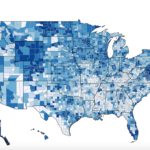
When To Use Scatter Charts in Business 10-31
- 0
Scatter charts, sometimes referred to as scatter plots or scatter graphs, are visual tools that showcase relationships between two sets of data. These charts are invaluable in a business setting, especially when trying to find a correlation or understand possible trends between two variables. They display data as a collection of points, each representing an observation. The position of each point is determined by the value of two variables: one plotted along the x-axis and the other plotted along the y-axis. But when exactly should a business use a scatter chart? Let’s delve into the appropriate scenarios.
Understanding Correlation
One of the primary uses of scatter charts in a business context is to identify the correlation between two sets of data. If a company wants to understand if there’s a relationship between advertising expenditure and sales, a scatter chart can help. For instance:
- If points cluster along a straight ascending line, there is a positive correlation, meaning as one variable increases, the other tends to as well.
- If the points cluster along a straight descending line, there’s a negative correlation, indicating that as one variable increases, the other tends to decrease.
- If the points are scattered without any discernible pattern, there is no correlation, suggesting that the two variables don’t influence each other.
Using scatter charts to identify relationships is particularly useful when making business decisions. If there’s a strong positive correlation between marketing spend and revenue, a business might decide to allocate more budget towards marketing.
Evaluating Patterns and Outliers
Apart from identifying correlation, scatter charts are also essential for spotting patterns and outliers. In business data, an outlier is a value significantly different from others in a dataset. They can arise due to measurement errors or genuinely unique instances.
For example, a company might analyze the relationship between employee experience (years of service) and their performance ratings. If most long-serving employees have high-performance ratings but one or two have particularly low scores, these individuals would be outliers on a scatter chart. Identifying these outliers helps businesses detect anomalies and then dig deeper to understand the reasons behind such anomalies. Perhaps these employees need retraining or are facing personal challenges. The scatter chart provides an initial visual cue that something may warrant further investigation.
Time-Series Analysis
Time-series analysis involves studying data points collected or recorded at specific time intervals. While other types of charts, such as line graphs, might be more commonly associated with time-series data, scatter charts can also be useful, especially when one wants to emphasize individual data points rather than continuous trends.
For instance, a business might use a scatter chart to compare monthly sales against a specific promotional activity each month. If sales peaks are consistently occurring in months with particular promotions, this insight can guide future marketing strategies.
Identifying Data Concentrations
In certain business scenarios, it’s not the individual data points that matter as much as the areas where data is most concentrated. Scatter charts can help visualize these concentrations. For instance, if a retail chain wanted to study the distribution of customers in relation to their stores’ locations, a scatter chart might reveal densely populated areas that currently lack a store. This information is vital for future store location planning.
When Considering Multivariate Analysis
While the standard scatter chart examines the relationship between two variables, multivariate scatter charts can be employed to study three or more variables simultaneously. This is achieved by adding more dimensions to the chart, like using varying sizes or colors for the dots. For example, a company could plot sales against advertising expenditure but use dot sizes to indicate the number of competitors in the market. Larger dots could indicate more competition. This approach offers a richer, more layered analysis in one visual.
Choosing the Right Tool for the Task
Scatter charts, like all data visualization tools, have their place in the business world. They are powerful instruments when looking to identify correlations, spot outliers, or understand data concentrations. While not suitable for every scenario (such as when dealing with categorical data or when the primary interest is in distributions), scatter charts shine in revealing the relationships between two or more variables.
As with any tool, it’s crucial to understand its strengths and weaknesses. In business, where decisions often hinge on accurate data interpretation, the scatter chart stands as an invaluable asset for clear, effective data visualization.






